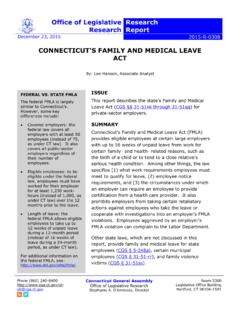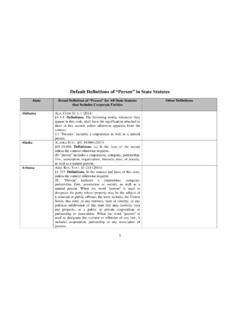Transcription of The Thirteen English Colonies - lowellville.k12.oh.us
1 The Thirteen English Colonies Chapter 3/4 Name: _____ Period: _____ Social Studies 7 Chapter 3/4: The 13 English Colonies (1630-1750) Theme: The Thirteen English Colonies were founded between 1607 and 1733. The colonists of these different Colonies hoped to find different things in the New World. Some sought economic opportunities while others left England for political or religious reasons. Regardless, the new English Colonies grew rapidly. The Colonies can be broken up into three different geographic regions: the New England Colonies , the Middle Colonies , and the Southern Colonies . Each region developed its own economy, form of government, and society. Objectives: At the end of this unit, students will be able to: Describe and compare colonial objectives of European nations and the methods they used to achieve those goals. Explain the geographic factors that helped shape where colonists settled and the economies that developed.
2 Identify and evaluate the factors that led to the early successes of failures of English colonization. Explain the religious, economic, and political reasons that motivated people to resettle in North America. Compare the geographic, political, religious, and social characteristics of the New England, Middle, and Southern Colonies . Identify, explain, and criticize the factors that led to the development of eighteenth-century American slavery; examine the experiences of slaves in eighteenth-century North America. Identify and explain the events that led to the development of democracy in the English Colonies ; explain the significance of the House of Burgesses and the Mayflower Compact; summarize the essential ideas of the Mayflower Compact. Read, examine, and interpret charts and maps related to the period. Analyze the primary source documents related to the period. Chapter Outline: I. Introduction II. Colonial Regions III. Founding the Original 13 Colonies IV.
3 Triangular Trade V. Colonial Government and Life VI. Middle Passage and Slavery VII. Review Probable Time Frame: Two weeks, Test is on Next Chapter: Chapter 3/4 DBQ Essay 1. Review Sheet Write the founder(s) of each colony on the line. Massachusetts _____ New Hampshire _____ Rhode Island _____ Connecticut _____ New York _____ New Jersey _____ Pennsylvania _____ Delaware _____ Virginia _____ The Carolinas _____ Maryland _____ Georgia _____ Define the following terms 1.) Import: 2.) Export: 3.) Mercantilism: 4.) Colony: 5.) Navigation Acts: 6.) Smuggling: 7.) Religious Toleration: 8.) Patroon: 9.) Racism: 10.) Indentured Servant: 11.) Slave Codes: 12.) Proprietary Colony: 13.) Royal Colony: 14.) Mayflower Compact: 15.) House of Burgesses: 2. 16.) Middle Passage: 17.) Triangular Trade: 18.) Bacon s Rebellion: 19.) Theocracy: 20.) Apprentice: 21.) List the Colonies of each region: 22.
4 Fill out the following chart. Colonial Region Land Climate Ways of Making Money New England Middle Southern 3. New England: 1) 2) 3) 4) Middle: 1) 2) 3) 4) Southern: 1) 2) 3) 4) 5) 23.) What were the qualifications to vote in the Colonies ? 24.) Describe what happened when John Peter Zenger wrote an article criticizing the governor: 25.) Fill in the trade goods travelling between each location as part of the Triangular Trade. 4. 13 ORIGINAL Colonies Directions: Complete the following chart using your text book pages 71, 77, and 84. NEW ENGLAND Colonies MIDDLE Colonies SOUTHERN Colonies LAND (soil conditions, fishing, etc.) CLIMATE (average weather, seasons) 6. Directions: Clearly label each colony. Next, shade in the New England Colonies , the Middle Colonies , and the Southern Colonies three different colors. Fill in the key with the colors that you labeled each set of Colonies . Use pg.
5 74, 80, 86 from your textbook to help you. Key New England Colonies Middle Colonies Southern Colonies 7. The Colonial Environment and Its Economic Impacts Colonial Region Land Climate Way of Making Money New England rocky, forested, poor soil long cold winters, very short growing season Fishing, whaling, shipbuilding, lumber Middle fertile river valleys milder winters, longer growing season Farmed, grew grains: Wheat, Rye, and Barley Southern flat coastal plains, broad rivers, fertile soil warm, moist summers, very short and mild winter plantations (large farms) where rice, indigo, and tobacco were grown Directions: Base your answers to the following questions on the chart seen above and your knowledge of social studies. Please answer in complete sentences. 1. What are the three colonial regions? _____ _____ 2. Why might the New England region make its money by doing things other than farming? _____ _____ 3. Explain a difference you notice about the crops grown in the Middle region and some of the crops grown in the Southern region.
6 _____ _____ _____ 8. 4. Why might the New England region be more successful than the Southern region at fishing, whaling, shipbuilding, and lumbering? _____ _____ _____ _____ _____ 5. Based on the chart and what else you have learned, explain how geography can affect the economy or way people make money. _____ _____ _____ _____ _____ _____ _____ _____ _____ _____ _____ 9. The Thirteen English Colonies Reason for Settling Religious Group Colony Key People Description Religious Quakers 1. 2. 3. Pennsylvania William Penn Believed in: Spoke out for: Set up a safe haven for Quakers Why? Holy Experiment: Puritans/ Pilgrims Massachusetts John Winthrop: Theocracy: What happened to those who opposed the governor? Catholics Maryland Lord _____ Established a safe place for Catholics. Why? Act of Toleration: 10. The Thirteen English Colonies Reason for Settling Economic Reason Colony Key People Description Economic Make money for the Virginia Company Investors Virginia John Smith Strict Rule: Why Founded Bacon s Rebellion: Coastal Land for Massachusetts New Hampshire Why Founded: A _____ colony Coastal Land for Pennsylvania (Trade & Fishing) Delaware Why Founded: Farming Land North Carolina Why Founded: South Carolina What makes North and South Carolina different?
7 11. The Thirteen English Colonies Reason for Settling Economic Reason Colony Key People Description Political To limit the power of the _____ Connecticut Thomas Hooker Banished from Massachusetts Bay: Set up new government/colony. Fundamental Orders of Connecticut: Challenged Governor s Authority Religious _____ Rhode Island Roger Williams Did not believe the King could: How did Williams get the land?: Religious Toleration: People upset under Dutch Rule Patroon: New York Peter Stuyvesant (Dutch) Originally a _____ colony. How did it become English ?: Power: Patrons Duke of York Assembly Prison Reform Buffer against Spanish Florida Georgia James Oglethorpe (Former Soldier) Why Founded: Gift to friends of the King New Jersey Proprietary Colony: Royal Colony: 12. 13. The Original Thirteen English Colonies Directions: Fill in the following chart about each colony. For Reason(s) for settling, list political, religious, or economic AND the specific reason each colony was settled.
8 For Type of Economy, consider the region the colony is a part of (New England, Middle, or Southern), and list the primary ways that money was earned for that colony. Colony Reason(s) for Settling Type of Economy 14. Colony Reason(s) for Settling Type of Economy 15. Triangular Trade 1650-1750 Import: Export: COLONY: Mercantilism: Navigation Acts: SMUGGLING: 16. Constructed Response Question Mayflower Compact Historical Context: The Pilgrims who came to America in 1620, were mainly a group of Christians called Separatists. Because of the harassment by the government in England, one group of Separatists had moved to the Netherlands in 1608, but became frustrated with conditions there and decided their hope lay in the new land of America. After anchoring inside the tip of Cape Cod (in Provincetown harbor) The Mayflower Compact, "the first plan for a self-determining government in America", was drawn up and signed by 41 men aboard the Mayflower on November 11th, 1620.
9 This agreement was believed to be necessary because there were rumors that some of the non-Separatists, called "Strangers," among the passengers would rebel against the Pilgrims if they landed in a place other than that specified in the land grant they had received from the London Company. The compact became the basis of a temporary government in the Plymouth Colony. After it was signed, the Pilgrims elected John Carver as their first governor. They were to meet in a yearly " general Court to elect the governor and assistants, enact laws, and levy taxes." IN The Name of God, Amen. We, whose names are underwritten, the Loyal Subjects of our dread Sovereign Lord King James, by the Grace of God, of Great Britain, France, and Ireland, King, Defender of the Faith, etc. Having undertaken for the Glory of God, and Advancement of the Christian Faith, and the Honor of our King and Country, a Voyage to plant the first colony in the northern Parts of Virginia; Do by these Presents, solemnly and mutually in the Presence of God and one another, covenant and combine ourselves together into a civil Body Politick(temporary government), for our better Ordering and Preservation, and Furtherance of the Ends aforesaid; And by Virtue hereof do enact, constitute, and frame, such just and equal Laws, Ordinances, Acts, Constitutions, and Offices, from time to time, as shall be thought most meet and convenient for the general Good of the Colony; unto which we promise all due Submission and Obedience.
10 In WITNESS whereof we have hereunto subscribed our names at Cape Cod the eleventh of November, in the Reign of our Sovereign Lord King James of England, France, and Ireland, the eighteenth and of Scotland, the fifty-fourth. Anno Domini, 1620 John Carver Edward Tilley Degory Priest William Bradford John Tilley Thomas Williams Edward Winslow Francis Cooke Gilbert Winslow William Brewster Thomas Rogers Edmund Margeson Issac Allerton Thomas Tinker Peter Browne Myles Standish John Rigdale Richard Britteridge John Alden Edward Fuller Georoe Soule Samuel Fuller John Turner Richard Clarke Christopher Martin Francis Eaton Richard Gardiner William Mullins James Chilton John Allerton William White John Crackston Thomas English Richard Warren John Billington Edward Dotey John Howland Moses Fletcher Edward Leister Stephen Hopkins John Goodman 17. 1. What is the Mayflower Compact? _____ _____ _____ _____ 2. Why did the Pilgrims think the compact was necessary?


